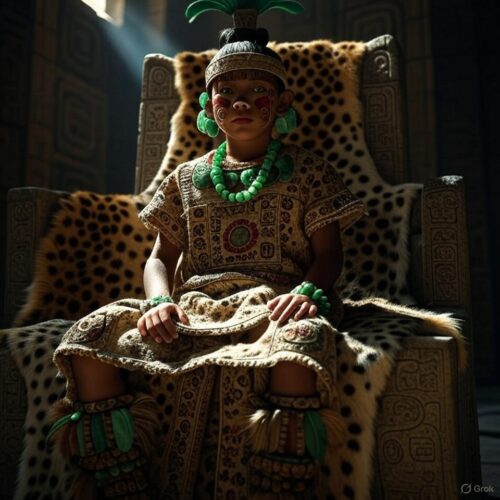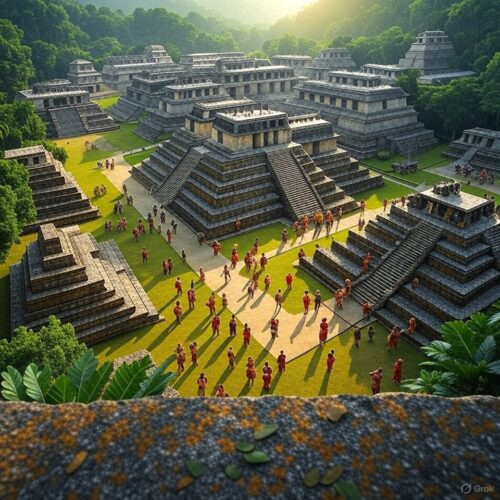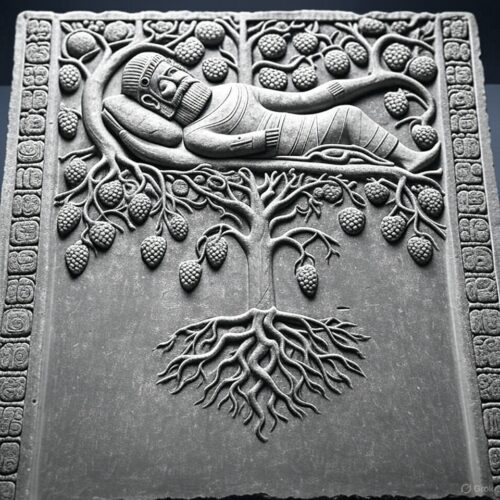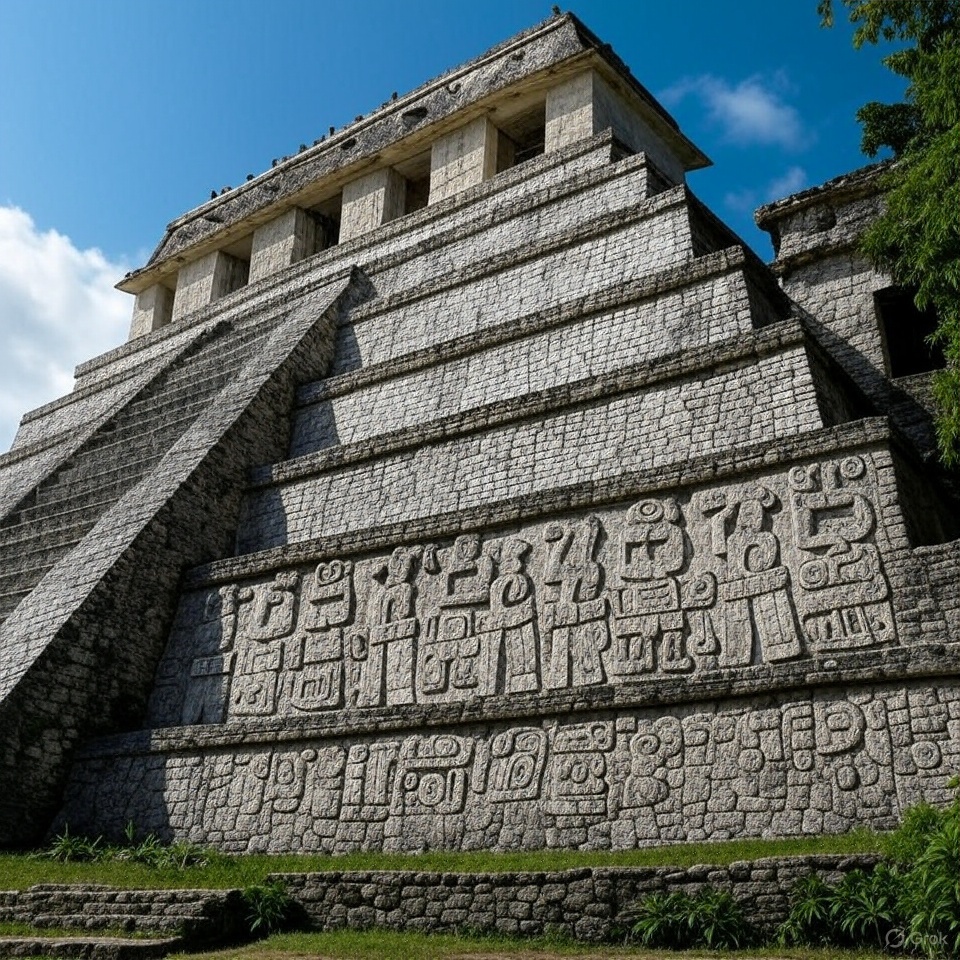Imagine a world where jungles hide pyramid cities, where kings rule as gods, and where a boy of just 12 years old steps onto a throne amidst chaos and calamity. On July 29, 615 AD, in the heart of what we now call Chiapas, Mexico, a young ruler named K’inich Janaab’ Pakal—better known as Pakal the Great—began one of the most extraordinary reigns in human history. This wasn’t just any coronation; it was a pivotal moment in the Maya civilization, marking the revival of a beleaguered city-state and setting the stage for architectural marvels that still baffle archaeologists today. In this blog, we’ll dive deep into the historical intricacies of Pakal’s life and times, exploring the rich tapestry of Maya culture, the trials of Palenque, and the enduring legacy of this remarkable leader. Then, we’ll bridge the centuries to uncover how his story can ignite personal growth in your life today, with practical, motivational insights to help you conquer your own “jungles.” Buckle up—this is going to be an epic journey through time, packed with facts, drama, and inspiration.
### The Enigmatic World of the Ancient Maya
To truly appreciate Pakal’s ascension, we must first step back into the vibrant, complex world of the Maya civilization. Flourishing from around 2000 BC to the Spanish conquest in the 16th century, the Maya were masters of Mesoamerica, spanning modern-day Mexico, Guatemala, Belize, Honduras, and El Salvador. Unlike the centralized empires of the Aztecs or Incas, the Maya organized into independent city-states, each ruled by divine kings called ajawob, who claimed descent from gods and mediated between the mortal realm and the supernatural.
The Maya era is divided into periods: the Preclassic (2000 BC–250 AD), where foundations of society were laid with early agriculture and pottery; the Classic (250–900 AD), the golden age of monumental architecture, intricate writing, and astronomical prowess; and the Postclassic, marked by shifts in power and eventual decline. Pakal’s time fell squarely in the Late Classic period (600–900 AD), a era of both splendor and strife. City-states like Tikal, Calakmul, and Palenque vied for dominance through alliances, marriages, and brutal warfare. The Maya developed one of the most advanced writing systems in the pre-Columbian Americas, using hieroglyphs to record history, genealogy, and prophecies on stelae (stone monuments), codices (folded books), and temple walls.
What made the Maya truly extraordinary was their intellectual achievements. They created a sophisticated calendar system combining the 260-day Tzolk’in (sacred calendar) and the 365-day Haab’ (solar calendar), forming the Long Count that tracked time over vast cycles. Their mathematics included the concept of zero, predating its use in Europe by centuries. Astronomy was central; they charted Venus’s cycles with astonishing accuracy, associating it with warfare and kingship. Religion permeated every aspect of life—gods like Itzamna (creator deity), Chaac (rain god), and the Hero Twins from the Popol Vuh epic influenced rituals, including bloodletting and human sacrifice to ensure cosmic balance.
Society was hierarchical: nobles and priests at the top, artisans and farmers below, with slaves captured in war at the bottom. Economy relied on maize agriculture, supplemented by beans, squash, and cacao (used as currency). Trade networks spanned continents, exchanging obsidian, jade, feathers, and shells. Artistically, the Maya excelled in polychrome pottery, jade carvings, and murals depicting mythological scenes. Yet, this brilliance coexisted with environmental challenges—deforestation and droughts may have contributed to the Classic collapse around 900 AD. In this dynamic backdrop, Palenque emerged as a jewel, and Pakal as its shining star.
### Palenque: Jewel of the Maya Lowlands
Nestled in the lush foothills of the Sierra de Chiapas, Palenque—known anciently as Lakamha’ (“Big Water”)—was a medium-sized Maya city-state that punched above its weight in cultural influence. Founded around 226 BC, it reached its zenith under Pakal and his successors. The site’s name comes from the nearby Spanish colonial town, but its true essence lies in its harmonious blend of architecture and nature. Waterfalls and streams cascade through the ruins, symbolizing the Maya’s reverence for water as a portal to the underworld.
Palenque’s core covers about 2.2 square kilometers, with over 1,000 structures identified, though only a fraction excavated. The city’s layout reflects Maya cosmology: temples atop pyramids represent sacred mountains, plazas mimic the earthly plane, and underground aqueducts evoke the watery underworld (Xibalba). Key features include the Palace complex, a sprawling administrative and residential hub; the Temple of the Inscriptions, Pakal’s masterpiece; and the Cross Group temples, dedicated to gods and royal ancestors.
Before Pakal, Palenque enjoyed prosperity under rulers like Casper (a nickname for an early ajaw) and Butz’aj Sak Chiik. But by the early 7th century, it faced existential threats from rival powers, particularly Calakmul, the “Snake Kingdom,” which dominated the central lowlands. Calakmul’s aggression aimed to subjugate weaker states, disrupting trade and tribute. Palenque’s location on trade routes for jade and quetzal feathers made it a prime target. Archaeological evidence, like burned structures and disrupted inscriptions, paints a picture of a city on the brink—yet it was from this ashes that Pakal would rise.
### Turbulent Times: The Lead-Up to Pakal’s Ascension
The years preceding July 29, 615, were a maelstrom for Palenque. In 599 AD, Calakmul’s forces, under ajaw Yuknoom Ch’een I, sacked the city, destroying temples and capturing elites. This “star war” (a Maya term for major conflicts) weakened Palenque’s ruling dynasty. Then, in 611, another assault by Calakmul’s Scroll Serpent further devastated the city, leading to the deaths of ajaw Ajen Yohl Mat in 612 and his heir, Pakal’s grandfather Janahb Pakal.
This created a vacuum. Pakal’s mother, Lady Sak K’uk’ (also known as Lady Beastie), a formidable noblewoman from the ruling line, assumed regency. Born into turmoil, Pakal entered the world on March 24, 603, during these dark days. His name, K’inich Janaab’ Pakal, translates to “Radiant…Shield” or “Sun-Faced Lord Shield,” evoking protection and divine light. His parents were Lady Sak K’uk’ and K’an Mo’ Hix, a noble tied to the dynasty.
The succession crisis was acute; Maya kingship was patrilineal but flexible, allowing maternal lines in emergencies. Lady Sak K’uk’ governed as regent, stabilizing the city through diplomacy and rituals. Inscriptions describe her as a “holy lady” who performed ceremonies to appease gods. By 615, at age 12, Pakal was deemed ready. His ascension on July 29—marked by rituals involving bloodletting, incense, and offerings—symbolized renewal. He was dressed in jade ornaments, a feathered headdress, and the royal bundle, affirming his divine status.
Interesting fact: Maya coronations often coincided with astronomical events. Pakal’s may have aligned with Venus’s position, seen as auspicious for warriors. This boy-king faced immense pressure: rebuild Palenque, avenge defeats, and secure the dynasty. Little did the world know, he would transform it into a powerhouse.
### Pakal’s Early Reign: From Boy-King to Visionary Leader
Pakal’s first decades were under his mother’s shadow, who ceded power gradually until her death in 640. As regent, she handled administration, allowing Pakal to learn governance. By his teens, he initiated reforms. In 626, at 23, he married Lady Tz’akbu Ajaw from a satellite site, strengthening alliances. Their union produced sons: K’inich Kan Bahlam II (635), K’inich K’an Joy Chitam II (644), and possibly Tiwol Chan Mat (648).
Military prowess defined early rule. In 628, Pakal captured a Piedras Negras official, signaling defiance. By 659, he seized six lords, including Ahiin Chan Ahk from Pipa’ (modern Pomona), sacrificing some in rituals to honor gods. These victories, detailed in hieroglyphs, boosted morale and tribute. In 663, more captures from Santa Elena made it a vassal. Pakal’s strategy blended force with diplomacy, forging ties with sites like Tortuguero.
Fun tidbit: Maya warfare wasn’t about conquest but captives for sacrifice. Pakal’s prisoners were often depicted bound on temple steps, their blood nourishing the cosmos. This “flower war” aesthetic combined brutality with artistry.
### Architectural Marvels: Building an Eternal Legacy
Pakal’s true genius shone in construction, starting at 44 with El Olvidado temple in 647. But the Palace expansion was legendary. Originally built centuries earlier, Pakal enlarged it into a labyrinth of courtyards, galleries, and towers. House E (Sak Nuk Naah), painted white amid red structures, featured the Oval Tablet showing his mother handing him the crown—symbolizing legitimacy.
In 661, Houses B and C rose, with C’s masks depicting captured lords. House A’s 668 frescos immortalized 662 prisoners. The palace included underground passages, aqueducts, and a tower possibly for astronomy. Pakal’s crowning achievement: the Temple of the Inscriptions, begun late in life. This nine-level pyramid housed his tomb, with a psychoduct (tube) linking sarcophagus to summit for his spirit’s ascent.
Archaeology reveals stucco reliefs, jade mosaics, and inscriptions narrating dynasty history. Pakal’s building boom employed thousands, using limestone, corbel arches, and vibrant paints. These structures weren’t just buildings; they were cosmic models, aligning with solstices and equinoxes.
### Family Dynamics and Succession Planning
Pakal’s family was central to stability. His wife, Lady Tz’akbu, played key roles in rituals, depicted in carvings. Sons were groomed: Kan Bahlam succeeded him, continuing projects. Grandsons like Ahkal Mo’ Nahb extended the line. Pakal’s longevity allowed mentoring, ensuring smooth transitions—a rarity in Maya politics.
Controversy: Some scholars debate if Pakal’s mother was truly regent or if inscriptions exaggerated her role to legitimize him. Gender in Maya rule was fluid; women like Lady Sak K’uk’ wielded power, challenging patriarchal views.
### Later Years, Death, and Deification
By his 70s, Pakal had elevated Palenque to unparalleled heights. He died August 29, 683, at 80—ancient for Maya standards. Deified as a patron god, his funeral involved elaborate rites. Buried in the Temple of the Inscriptions’ sarcophagus, carved with his descent into Xibalba on the World Tree, surrounded by ancestors emerging as trees.
The lid, famous for its “astronaut” interpretation by pseudohistorians like Erich von Däniken (debunked as mythological), shows Pakal falling into the underworld. Tomb treasures: jade mask, necklaces, rings—symbols of eternity.
### Archaeological Rediscovery: Unlocking Pakal’s Secrets
Palenque lay hidden until 18th-century explorers. In 1948, Alberto Ruz Lhuillier discovered the tomb’s staircase, filled with rubble. By 1952, he unearthed the sarcophagus, shocking the world—Maya pyramids were thought funerary only in Postclassic. Bones confirmed Pakal’s age via recent analysis, resolving early doubts from dental wear (due to soft diet?).
Excavations revealed red mercury paint on bones (cinnabar for preservation) and stucco figures. DNA studies link him to the dynasty. Today, Palenque is a UNESCO site, drawing visitors to marvel at Pakal’s vision.
Interesting controversy: The “astronaut” theory persists in pop culture, but experts see it as Pakal on the cosmic axis, embodying Maya worldview.
Pakal’s reign, spanning 68 years, outlasted many empires. He turned defeat into dominance, blending war, art, and faith. His story isn’t just history—it’s a blueprint for resilience.
### From Ancient Throne to Modern Mastery: Applying Pakal’s Lessons Today
Pakal’s tale isn’t confined to ruins—it’s a motivational rocket fuel for your life. Rising from chaos at 12, he teaches that age, adversity, or origins don’t define destiny. Here’s how his historical triumphs translate to personal benefits, with specific bullet points and a step-by-step plan to implement them. Remember, while history dominates our dive, these insights pack a punch to motivate you forward.
Specific Benefits from Pakal’s Historical Fact in Your Individual Life:
– **Long-Term Vision Builds Lasting Success**: Pakal planned buildings that endured centuries; today, this means setting decade-long goals, like career advancement or skill mastery, leading to fulfillment and legacy.
– **Resilience in Crisis Fuels Growth**: Facing sacks and crises, he rebuilt—apply this by turning job loss into skill-building, reducing stress and boosting confidence.
– **Mentorship Accelerates Achievement**: Under his mother’s regency, he learned wisely; seek mentors for advice, speeding up promotions or personal development by 20-30% as studies show.
– **Strategic Alliances Enhance Opportunities**: His marriage and vassals expanded power; network intentionally, like joining professional groups, opening doors to collaborations and income boosts.
– **Creative Innovation Solves Problems**: His architectural feats innovated Maya design; innovate in daily tasks, like using apps for productivity, saving hours weekly.
– **Balance of Power and Humility Sustains Leadership**: Deified yet family-focused, he balanced ego; practice humble leadership at work, improving team dynamics and job satisfaction.
– **Lifelong Learning Extends Impact**: Ruling 68 years with constant adaptation; commit to continuous education, like online courses, enhancing employability and mental sharpness into later years.
– **Cultural Pride Strengthens Identity**: Embracing Maya heritage, he inspired loyalty; explore your roots for deeper self-understanding and motivation.
A Practical Plan to Apply Pakal’s Ascension to Your Life:
- **Reflect on Your ‘Ascension Moment’ (Week 1)**: Journal about a past challenge, like Pakal’s at 12. Identify lessons, set a 10-year vision board with images of goals.
- **Build Resilience Rituals (Weeks 2-4)**: Daily meditate 10 minutes on setbacks as opportunities. Enroll in a skill course, mimicking Pakal’s learning under regency.
- **Forge Alliances (Months 1-3)**: Attend 3 networking events or reach out to mentors. Track new connections and how they aid goals.
- **Innovate and Create (Months 4-6)**: Tackle a project, like a home improvement or work initiative, incorporating creative twists. Document progress like Maya inscriptions.
- **Sustain and Legacy-Build (Ongoing)**: Review quarterly, adjust plans. Share your story via blog or talks, inspiring others as Pakal’s legacy does.
Embrace Pakal’s spirit—turn today’s date into your turning point. History shows greatness starts young, endures long, and echoes forever.

